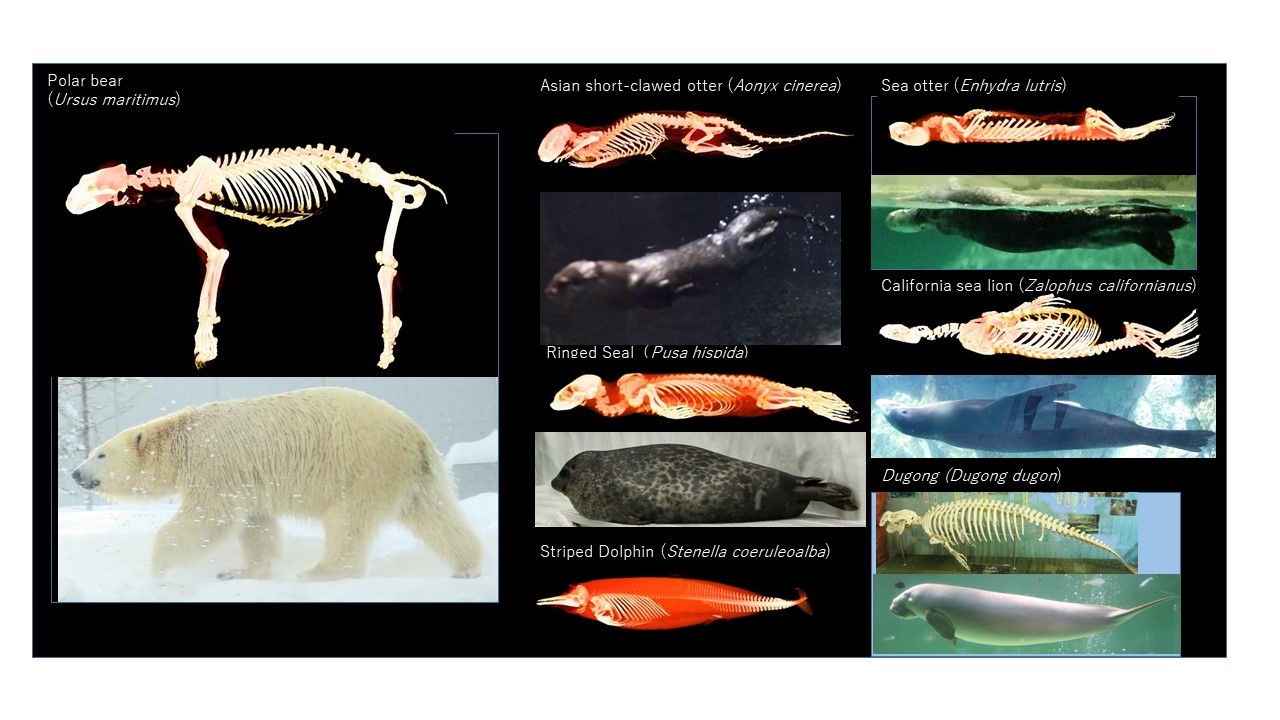
Swimming is an almost universal ability among mammals, including aquatic, semiaquatic and terrestrial species - a recent report even described competent swimming by a fruit bat. Mammals are secondary swimmers, meaning that even wholly aquatic species such as whales and dolphins have are descended from terrestrial ancestors, which may have returned to the water in order to access foods or escape from terrestrial predators. Primary swimmers are those whose entire evolutionary history is aquatic, such as fish. Many terrestrial mammals can swim, using cranio-caudal movements of the hind feet/or forefeet. The semi-aquatic mammals, such as otters and platypus, have physical adaptions for swimming such as webbed feet whereas the fully aquatic mammals such as whales and dolphins, manatees and seals have limbs and tail modified into flippers or fins. All aquatic mammals swim using vertical undulation of a flexible spine. This vertical movements is characteristic of mammals, and evidence of a terrestrial ancestry. In the primarily aquatic fish, swimming is achieved using lateral (side to side) oscillations of the body axis and tail (ref.5, 7).
The overall density of the mammalian body is typically in balance with that of water, giving neutral of positive buoyancy in most cases. With the limbs no longer required to support the body weight, locomotion in the water can achieved by paddling to generate thrust and control direction. Swimming by mammals can be divided into four broad types according to the means of generating thrust, as follows:
Many terrestrial animals swim by paddling their legs. Sloths, which spend the most of their lifetime in trees, and elephants, which are the heaviest animals on land, can swim very well in this way. The polar bear is one of the best swimmers among terrestrial animals, reportedly able to travel 70 km per day on land, or more than 60 km in the water with most thrust generated by paddling the forelimbs (Wikipedia).
Webbed feet allow semiaquatic mammals such as platypus, otters, hippos, coypu and beavers to achieve high mobility both on land and in the water. The webbing comprises a thin membrane of skin between the digits, which increases the surface area of each paddle in contact with the water, thereby increasing thrust. Otters have high mobility in the body axis and use bending and extension of the spinal column to produce vertical movements. In some animals with webbed feet, such as beavers and otters, the tail is flattened or paddle-shaped to aid swimming.
Pinnipeds swim and dive using pectoral and/or hind limbs modified into flippers. The flippers are also used for locomotion on the land, but while the eared seals can support body off the ground on the flippers in the manner of terrestrial quadruped mammals, in the true (phocid) seals and walrus the limbs have lost the ability to keep the body raised. A further difference is also apparent in swimming, wherein phocid seals use pelvic oscillation to undulate the paired hind flippers in the lateral plane, whereas fur seals and sea lions use pectoral flippers as oscillatory hydrofoils. Both flipper-based propulsive mechanisms generate remarkable lift-based thrust and maneuverability. The swimming speed of California sea lions reaches around 30 km/h.
Cetaceans and sirenians are completely aquatic mammals with a long, thick, muscular tail and large tail fins or flukes. They swim by beating the tail in a dorsoventral (vertical) plane. Both taxa have a streamlined body shape to reduce turbulent flow and resistance from the water. The powerful tail movements, require these animals to have rather stiff bodies. It has been reported that the top speed of dolphins reaches around 50 km/h (Wikipedia).
Figure legend
Lateral views of the whole body skeletons of good swimmers.

Fig. 33 Aquaticlocomotion1,Whales and dolphin produce hydrodynamic force by dorso-ventral tail beat.
2,Fur seals and sea lions use pectoral and pelvic flippers. 3,many terrestrial mammals swim using
pedaling of hind limbs and/or forelimbs.